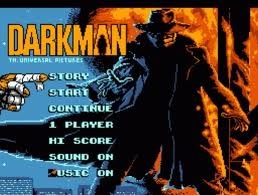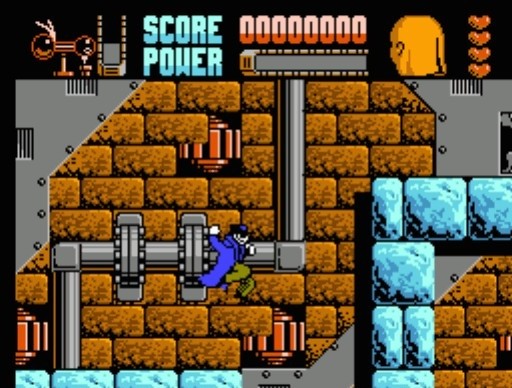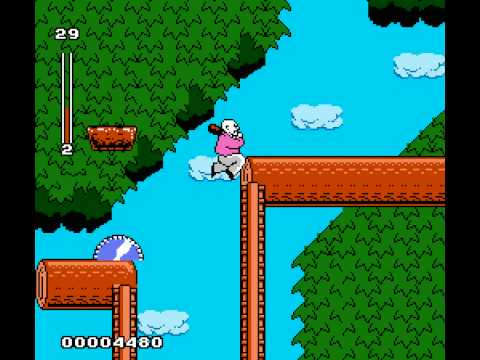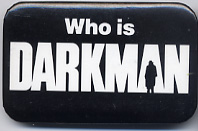Intro: Throughout the history of videogames, various consoles have served as one of the many pulpits for the gospel of film marketing. Videogame adaptations of movies are a strange breed. Motion Pixels will examine one such game each week, dissecting the basic gameplay, the graphics, and how faithfully it adapts the film on which it is based. Some are good, some are awful, and some are just down right weird, but they are all interesting experiments. We will also take a look at other cogs in a given film’s marketing machine. Grab some popcorn and a joystick and let the games begin!
Game/Movie: Darkman
System: Nintendo Entertainment System
Developer: Ocean Software
Year of Release: 1991
Graphics and Mechanics:
Darkman is an awesome game; actually it sits among the sterling examples of movie licensed videogames. It grabs you from moment one as the familiar, inviting, blue Ocean Software logo appears. Then Darkman’s fantastic poster fills the menu screen and your cursor is in the shape of one of his bandaged, mummified fingers—a finger that coils and stretches between each option for added realism.

The game operates exactly as an adventure platformer should, with each level presenting new layouts and challenges while holding to certain themes that themselves change every third or fourth round. If your wont is to avoid the down and dirty details, I would surmise by saying Darkman is addictively entertaining with immense replay value. If not, please read on.
The graphics are impressive within the context of the 8-bit universe, and I appreciate the inclusion of kinetic backgrounds, interstitial story threads, and villains altered to suit changing level themes. There was an interesting, if unintentionally humorous, “game over” screen featuring a single tear falling from Darkman’s dejected eyes and text below espousing “grief and rage prepare you for another try.” I couldn’t help but laugh each time I saw it because it cast our hero in a less-than-intimidating light and suggested his next move would less likely be fighting back as it would be listening to an Iron and Wine CD and attempting to find himself. On the other hand, as Darkman is a considerably difficult game, this screen poignantly captured my actual grief and rage as I stumbled my way through its levels.
The music is also superb, harboring that 8-bit orchestral mix with some nifty science fiction sounds effortlessly interwoven. It took me back to the days when game soundtracks were limited to only a few notes and sounds and yet artists were able to churn out some wonderful electronic symphonies. This excellence-beyond-means is the reason certain games can easily be recognized by merely humming their techno theme songs; The Legend of Zelda and Super Mario Brothers leap immediately to mind. And while I wouldn’t necessarily assign the Darkman game soundtrack such a lofty rank, its themes compliment the gameplay perfectly. The music in the third level is especially catchy.
As far the mechanics go, I really have only one complaint. One of the beauties of classic gaming—and, more specifically, console controllers featuring two-button setups—is that even a novice gamer can usually grasp the basic gameplay fairly quickly. True to this form, the Darkman NES game offers one button for jumping and another for attacks. While the jumping is moderately consistent in its execution, the fighting mechanics are a bit flaccid. The natural inclination when approached by a baddie in a game is to keep pressing the attack button until said baddie is no more. In Darkman, for the first few frustrating run-throughs, the punching and kicking proved strangely impotent and it became tantamount to battling an end-of-level boss each and every time you encountered an entry-level thug. It wasn’t until after a half a dozen defeats and a gross of smoke breaks that I discovered the unique, if irritating, button-mashing strategy that needed to be utilized in order to achieve victory. Instead of a steady stream of constant taps on the button, I had to make sharp, staccato strikes as if I were playing a piece of music in a 4/4-time measure. It’s an odd idiosyncrasy of the game, but one easily corrected and therefore negligible.
Playing Before Seeing The Movie
Since so many of these games are based on major properties that have to have a wide fanbase in order to effectively capitalize on the licensing, it is very rare that a game in my collection is based on a film I have not seen. Yet, such is the case with Darkman. Like most geeks, I am no slight Sam Raimi fan, but I just never got around to popping in the HD-DVD copy of Darkman. My first instinct was to sit down and watch the film prior to visiting with the long-neglected, dust-gathering NES cartridge on the shelf. But then I considered the more interesting approach of playing the game first and then trying to mine expectations of the film from the game. This would both illustrate how faithfully the game adapts the film and clearly identify the manufactured elements logistically necessary to construct a playable videogame.
So based on what I know of the game, here are the things I expected to see in the Darkman film…
- A plot point about Darkman making masks and assuming the identities of his foes
- Giant, leaping mutant fish
- Kitschy 70s knick-knacks, namely the water-drinking bird
- A superhero who cries at the slightest setback
- Plenty of amateur photography
- Darkman’s attempts to fight crime thwarted by his arch nemeses: ninjas, clowns, and birds
- Angry lumberjacks and a storyline about Darkman’s attempts to save an endangered redwood forest
Playing After Seeing the Movie
So let’s check the board and see how accurate a picture is painted of Darkman from its videogame. The game is actually among the more faithful adaptations I’ve seen and in fact devises its entire structure from the plot of the film…with a few exceptions. Indeed Darkman does make masks of the various henchmen, and this is indeed accomplished via Polaroids he snaps of them. Which is why every fourth level or so is a shooting-gallery type setup wherein you must aim your camera lens at various windows and take photos of a designated goon. The game then has you play as that goon for three to four more levels and effectively alters the landscape of those levels to make a distinctive world for each villain.
This collaboration of themes pretty closely charts the plot of the film: going from dingy industrial complexes that echo the dilapidated building in the film that serves as his lair...

...to Chinatown to a carnival funhouse to finally the sprawling construction site that hosts the films climax. Each of these places is present in the game to varying degrees of importance so it was really only a matter of augmenting those locations that served less significant function to the actual plot, tossing in a few environment-appropriate foes, and randomly assigning a henchmen to that level.
The exception to this rule is the rustic woodsy levels that are complete non-sequiturs to the film.

How bulging, lumbering crony Paulie got assigned to the forest I’ll never---wait, lumbering...lumber…no, that can’t be it. While Darkman doesn’t assume the identity of all the henchmen as he does in the game, and while the 8-bit designs of a majority of said villains are less-than-accurate, it still plays well to one of the film’s central conceits.
The helicopter levels are among the most pitch-perfect film recreations in the game. Identical to the events of the movie, you are suspended from a helicopter and dangled before oncoming traffic. You must avoid trucks, motorcycles, and grenades being launched down at you from above. The added element in the interest of more challenging gameplay would be the maurading, albeit cheerful-looking, birds that were the bane of my existence each and every time I encountered this level.
As absurd as I believed the crying hero graphic to be, it turns out to be downright apt when considering the film. They insert a hackneyed medical explanation for it in the movie, but my good God does Darkman cry profusely! He’s a bit of a whiner, which apparently has something to do with a cerebral compensation for the fact that his body can’t process pain responses. This would all be well and good if the film in any way played up the “he can’t feel pain” element of the story, but since it’s such an abandoned concept, we are left with only the weeping. Cheer up emo Darkman!
Mission Accomplished?
It is with a heavy, shame-laden heart that I must confess I failed to beat the Darkman game for NES within the seven-day timeframe I give myself. After consulting some online walkthroughs, I learned that I was a mere four levels from the end but it became too arduous a task to again reach that point with enough spare lives/continues to advance. That’s not to say I won’t keep trying, but for now I must wave the white flag.
What about you? If you’ve had the good fortune to play this game, and can recall doing so, were you victorious? What advice can you offer me?
Final Thoughts
Again, the rarity of my playing the game prior to seeing the movie offered a duality of perspectives on each. I had as much, and similar varieties of, fun playing the game as I did watching the film and feel the two benefit each other nicely. The one thing I did notice while watching the HD-DVD is that the representation of the world of the film is probably better served in 8-bit than in high-definition as the hopelessly-dated, budget-confined effects of the film are strikingly more apparent in HD.
License to Sell
I truly miss the days of promotional movie buttons. My good friend Kayla managed to horde a massive collection of them over the years and has made a habit of bestowing them to me one-at-a-time as a reward for knowing inconsequential trivia about the films featured. If she has this Darkman button...

...I must really pester her for one. To obtain it, perhaps I’ll be forced to name the comic book character Sam originally wanted to adapt in the early 90s but couldn’t get the rights to, and therefore settled for creating his own in Darkman. The answer, in case you’d like to someday potentially win this amazing button, is The Shadow.
